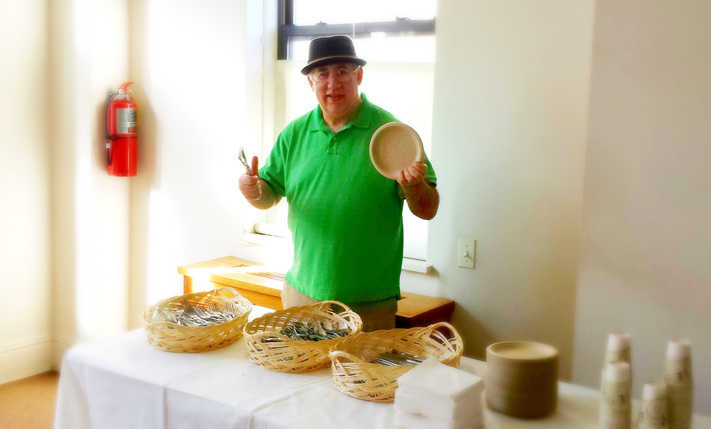Greening often happens in supply closets. On roofs. In the boiler room. Out of sight.
To bring greening out of the shadows, it’s important to make it a visible part of your programming.
For synagogues, weekly kiddushes offer the perfect opportunity to highlight greening work already underway and demonstrate that greening is a Jewish value. Kiddush, which means sanctification, was intended as a way to sanctify Shabbat and remind us to take a rest from our workday labors and enjoy the beauty of creation. But what could be a better way to sanctify the day than creating a healthier, less wasteful kiddush?
Organizing a sustainable kiddush is an ideal first step for synagogues that have little experience in greening: it’s easier than a facility upgrade and requires less upfront effort and investment… but it can help the congregation get into better habits and build momentum for additional projects. For synagogues already steeped in greening, the kiddush – with its large, captive audience – offers an excellent opportunity to raise the profile of existing greening measures.
Hosting a sustainable kiddush also provides a way to pilot changes in operations, testing their feasibility and congregants’ opinions as a springboard for broader change. For example, if composting one week’s kiddush waste proves to be low-cost, logistically straightforward, and popular among congregants, the green team can work to make it a permanent fixture of kiddush. But taking the first, easy step is crucial.
While schools, JCCs, and social service agencies don’t hold kiddushes, they can green any of their weekly programs using the same principles.
Numerous JGF synagogues have held green kiddushes. Last year, Congregation Ansche Chesed’s executive director, Josh Hanft, arranged for the city to begin picking up composting from the weekly kiddush, and switched from plastic to reusable metal cutlery, which drastically reduced the amount of trash created at kiddush. Congregants welcomed the transformation: During Passover, when the congregation temporarily stopped composting, congregants clamored for its return. (Email Josh – JHanft@anschechesed.org – for more further guidance.)

JGF Fellow Josh Hanft shows off the reusable cutlery used at Ansche Chesed’s kiddush.
But you don’t have to focus your kiddush greening efforts on waste alone. At Kane Street Synagogue, congregants decided to make healthier kiddushes; they cooked fresh, delicious dishes for the kiddush in the synagogue kitchen. Led by Jewish Greening Fellow Rabbi Valerie Lieber, they also found a fantastic opportunity to empower children in the kiddush greening process: students in Kane Street’s Hebrew school learned how to sort waste between garbage, recycling, and compost, and in turn stood by the receptacles and trained adults.
To green your kiddush, or other weekly program, consider:
- Serving locally-grown vegetarian food to reduce your carbon footprint, prevent the mistreatment of animals, and promote better health.
- Arranging composting through a local farmer’s market, CSA, commercial hauler, or city collection program. See NYC’s Compost Project for assistance.
- Filling the kiddush cup with organic grape juice or wine.
- Buying reusable tablecloths, reusable water jugs, and reusable or compostable plates to reduce plastic use. Also consider improving your recycling program and installing clearly marked waste-sorting stations.
- Cutting out soda. Instead serve fruit juice or fair trade coffee and tea.
- Above all, educate! Make an announcement before Kiddush, create table tents and resource sheets available explaining the kiddush, and ask the rabbi to devote his/her sermon to greening. Visit Hazon’s Shmita webpage for educational ideas.
For other ideas, explore the Riverdale Y’s Green Kiddush Guide or Hazon’s Sustainable Shabbat guide.
When should you hold a green kiddush? Spring and summer are ideal, since local produce is readily available. Shabbat Behar, on May 15-16, or a shabbat shortly thereafter, offer an opportunity to celebrate the Shmita year, which the Torah describes as a time to let the land rest and to forgive debts – a year-long Shabbat for the earth and its inhabitants. The parsha (weekly Torah reading) of Behar presents one of the Torah’s passages on Shmita. Last year, communities all around the country marked the period around Shabbat Behar with Shmita-themed events. We read about Shmita again in the portion Vayelech on August 15th. Let us know if you are planning an event.




Comments are closed.